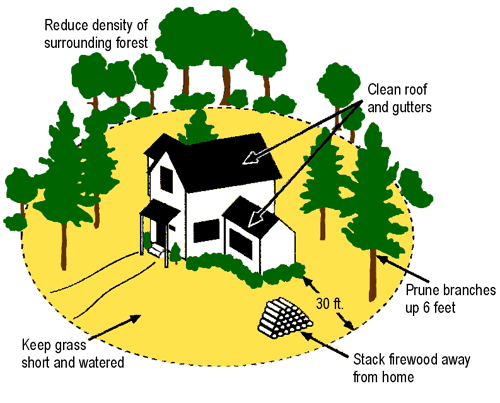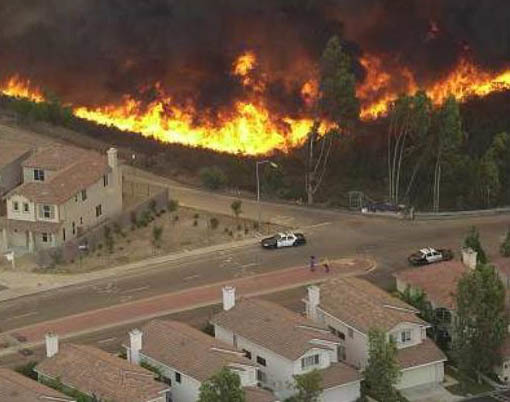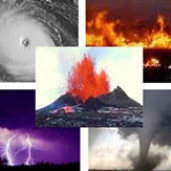
According to the National Park Service, as many as 90% of wildland fires in the United States are caused by humans.
Some human-caused fires result from campfires left unattended, the burning of debris, negligently discarded cigarettes, recreational vehicles, target shooting (including exploding rifle targets), and intentional acts of arson.
The remaining 10% are started by lightning or lava.
As our population continues to grow, more and more people are building homes in places that were once pristine wilderness areas. Homeowners who build in remote and wooded areas must take responsibility for the way their buildings are constructed and the way they landscape around them.
WILDFIRE MITIGATION TIPS
Use Fire Resistant Building Materials – The roof and exterior structure of your home and other buildings should be constructed of non-combustible or fire-resistant materials. If wood siding, cedar shakes or any other highly combustible materials are used, they should be treated with fire retardant chemicals.
Landscape wisely – Plant fire-resistant shrubs and trees to minimize the spread of fire and space your landscaping so fire is not carried to your home or other surrounding vegetation. Remove vines from the walls of your home.

Create a “safety zone” or defensible space around the house
- Mow grass regularly.
- Stack firewood at least 30 to 100 feet (10 to 30 m) away and uphill from home.
- Keep roof and gutters free of pine needles, leaves, and branches and clear away flammable vegetation at least 30 to 100 feet (9 to 30 m) from around structures.
- Thin a 15-foot (4.5 m) space between tree crowns and remove limbs within 10-15 feet (3 – 4.5 m) of the ground.
- Remove dead branches that extend over the roof.
- Prune tree branches and shrubs within 10 feet (3 m) of a stovepipe or chimney outlet.
- Remove leaves and rubbish from under structures.
- Ask the power company to clear branches from power lines.
- Keep combustibles away from structures and clear a 10-foot (3 m) area around propane tanks, boats, etc.
- Review Cal Fire’s helpful diagrams on making a Defensible zone
Protect your home
- Install smoke detectors, test them each month and change batteries once a year.
- Install protective shutters or fire-resistant drapes.
- Inspect chimneys twice a year and clean every year.
- Cover chimney and stovepipe flue openings with 1/2 inch (1 cm) or smaller non-flammable mesh screen.
- Use same mesh screen beneath porches, decks, floor areas and home itself. Also screen openings to attic and roof.
- Soak ashes and charcoal briquettes in water for two days in a metal bucket.
- Keep a garden hose connected to an outlet.
- Have fire tools handy (ladder, shovel, rake, ax, etc.)
- Put your address on all structures so it can be seen from the road.
Campfire Safety - Campfires are a common cause of brush fires or wildfires so please be careful when you’re out in deserts, mountains, or any other heavy vegetation areas.
NEVER leave a campfire burning – make sure it is completely out using plenty of water before leaving the area. Stir the coals around with a stick or log while pouring water over them to ensure all the coals get wet and they are no longer hot. Any hot coals left unattended can be easily ignited by wind since they can stay hot for 24 – 48 hours.
When building a campfire, always choose a level site, clear away any branches and twigs several feet from the fire, and never build a fire beneath tree branches or on surface roots. Also, build at least 10 feet (3 m) from any large rocks that could be blackened by smoke or cracked from a fire’s heat.
See your local Forest Service office or Ranger Station for more information on campfires and permits or visit www.fs.fed.us or www.pc.gc.ca

BEFORE A WILDFIRE (FIRE SAFETY TIPS):
Prepare – See Mitigation tips above and download & share a free portion of USFRA's Family Preparedness ebook
Learn fire laws – Ask fire authorities or the forestry office for information on fire laws (like techniques, safest times to burn in your area, etc.)
Could they find & reach you? – Make sure that fire vehicles can get to your property and that your address is clearly marked.
Safety zone – Create a 30-100 foot (9-30 m) safety zone around your home. (see above graphic)
Teach kids – Explain to children that matches and lighters are TOOLS, not toys… and if they see someone playing with fire they should tell an adult right away. And teach kids how to report a fire and when to call 9-1-1.
Tell authorities – Report hazardous conditions that could cause a wildfire.
Be ready to evacuate – Listen to local authorities and leave if you are told to evacuate.
DURING A WILDFIRE:
Listen – Have a radio to keep up on news, weather and evacuation routes.
Evacuate? – If you are told to leave – do so … and IF you have time also…
- Secure your home – close windows, vents, all doors, etc.
- Turn off utilities and tanks at main switches or valves.
- Turn on a light in each room to increase the visibility of your home in heavy smoke.
- See Mitigation tips above.
Head downhill – Fire climbs uphill 16 times faster than on level terrain (since heat rises) so always head down when evacuating the area.
Food & water – If you prepared ahead, you’ll have your Disaster Supplies Kit handy to GRAB & GO… if not, gather up enough food and water for each family member for at least 3 days or longer!
Be understanding – Please realize the firefighters main objective is getting wildfires under control and they may not be able to save every home. Try to understand and respect the firefighters’ and local officials’ decisions.
AFTER A WILDFIRE:
Don’t go there – Never enter fire-damaged areas until authorities say it’s okay and watch for signs of smoke or heat in case the fire isn’t totally out.
Critters – Don’t try to care for a wounded critter — call Animal Control.
Utilities – Have an electrician check your household wiring before you turn the power back on and DO NOT try to reconnect any utilities yourself!
Damage – Look for structural damage (roof, walls, floors) — may be weak.
Call for help – Local disaster relief services (Red Cross, Salvation Army, etc.) can help provide shelter, food, or personal items that were destroyed.
Insurance – Call your insurance agent or representative and…
- Keep receipts of all clean-up and repair costs
- Do not throw away any damaged goods until an official inventory has been taken by your insurance company.
If you rent – Contact your landlord since it is the owner’s responsibility to prevent further loss or damage to the site.
Move your stuff – Secure belongings or move them to another location.
Above from It’s A Disaster! …and what are YOU gonna do about it?

